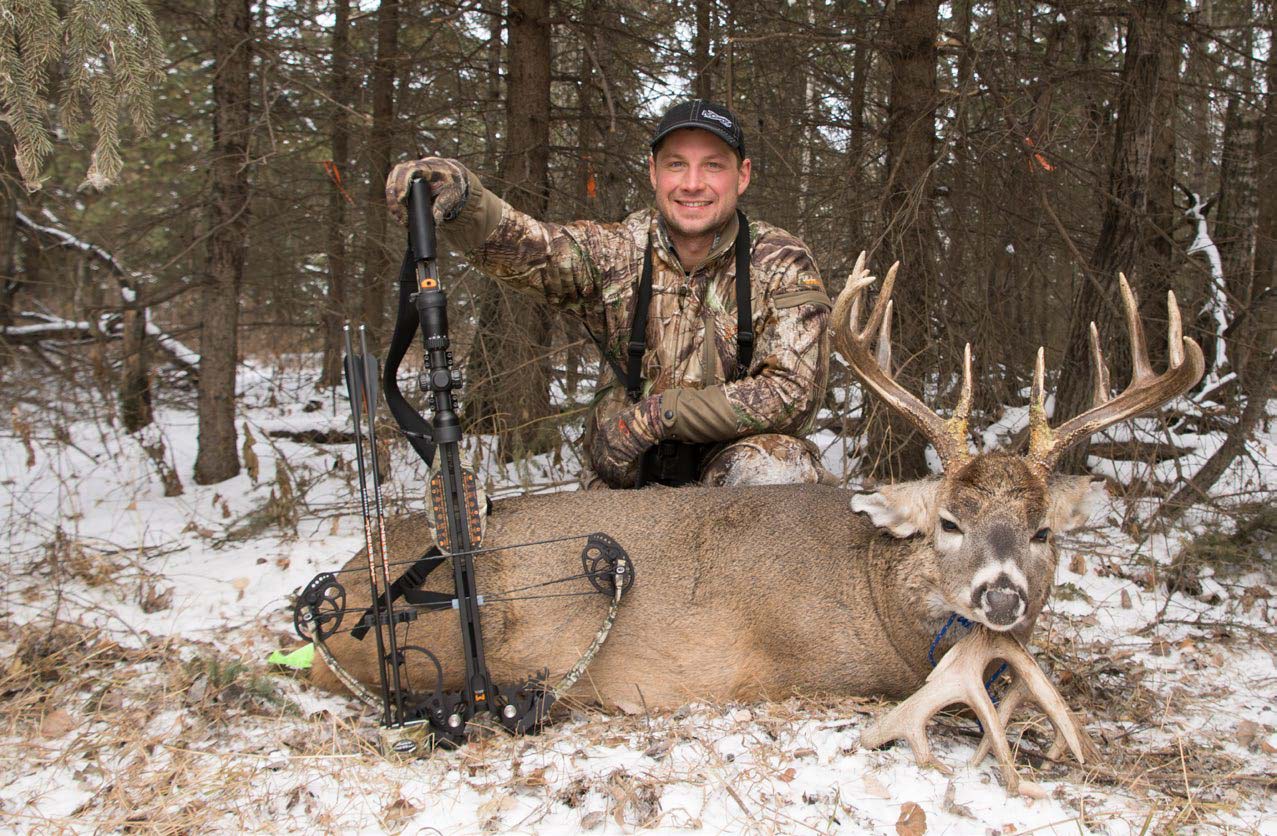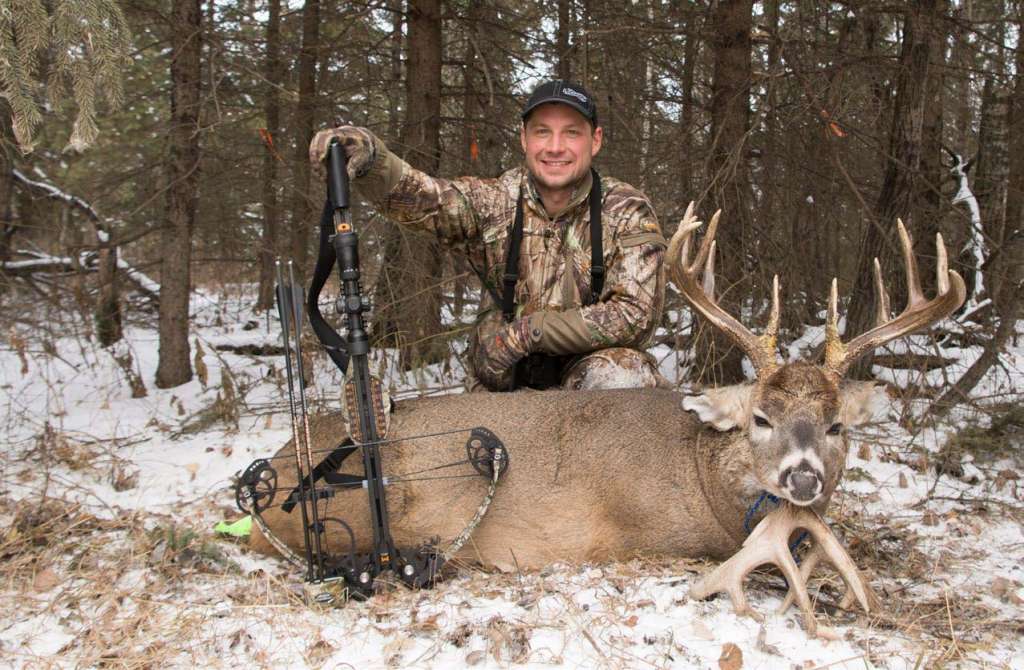
Before the rut occurs in November the first and final fifteen minutes of shooting light is prime time for whitetail deer movement towards feeding areas. You do not need to be a wildlife biologist to know that white tail deer prefer the safety of feeding in open crop fields under the cover of darkness. On the right night you can catch them coming in early but just before legal light ends. In order to capitalize during these critical fifteen minutes at dawn and dusk you want to have a good location, a solid strategy and proven equipment. These three pillars will ensure success in folding your tag.
It all begins with scouting. Finding food sources that deer are addicted to you during the summer months is key to deciding on a location to hunt during the fall. Some of the early season crops like canola are gold mines for big bucks. Often you will see their velvet antlers painted yellow. A favorite food of deer after the first frost occurs in the fall is alfalfa. I personally love hunting alfalfa fields because of the consistency they provide into attracting whitetail deer.
Regardless of the actual crop in the field, you want to check out the edges of the field for incoming and exiting trails. All edges eventually lead to another edge, and thus a corner and that’s where I would spend most of my time investigating a good hunting site. Often, there are numerous game trails used for entering or exiting the field and it’ll be next to impossible to cover them all. Although it may be tempting to set up on these well used trails and pick one or two of them, I would advise against. Instead, follow the trails back into the bush and cover to find where they branch off a main trail. if you can find the intersection of two of these main trails, it doubles your chances and is a good spot to set up. Other times the majority of trails funnel back in towards a pinch point. It might be ascending a steep bank or a path of less resistance through a thicket or a shallow river crossing. Those well-defined trails are a good spot to set up because of the density of deer using that part of the travel route.
Rubs and scrapes are all part of the rut and they began in early October. If you happen to find a community scrape, the largest scrape in the area and visited by multiple deer to distribute scent, set up on it. If you stay put long enough at that scrape, you will eventually see every deer in the area. Rub lines are great when targeting a good buck. You can usually find them as they approach these feeding fields. Take note of the size of tree, the larger it is, the larger the buck making it is. A feeding area that has a good density of dear frequently feeding it and a good understanding of deer movement in/out of the area is an essential first step, next is choosing a hunting strategy.
As with any strategy for hunting your first consideration should be the wind. Ideally you want a five KPH wind blowing away from your shooting lanes. If the wind is not right do not bother hunting as you will do more damage by educating of your presence. I always carry a wind indicator with me. It helps know exact wind directions and velocities on the ground and accounts for local objects not picked up by the closest weather station.
Still hunting is not that popular of a hunting strategy when it comes to whitetail deer. Most people prefer to let the deer do the moving and have the hunter stay still and I would agree with this strategy just based on its historical success rates. However, staying put still means you need to get in and out of position in both the morning and the evening. For morning hunts enter your hunting spot away from the feeding field. You need to assume that the deer are in the field feeding and they will return to cover to bed down for the day. You want to find a way into your hunting spot nowhere near the feeding field. The reverse is true when hunting in the evening. You have to assume that the deer are bedded in cover and will begin entering the field as the sun goes down. I usually walk straight across or along the field and then take my own trail into my hunting spot. I tried to avoid at all costs walking along deer trails when going in or out of my spot.
Try to avoid setting up on the edge of a field. Although the sign can be spectacular, you have to consider the ability to get in and out of the stand undetected. In the morning you do not want to have to be near the field so having a static spot setup there is not ideal. In the evening it might be easy to get into this hunting spot, but if the deer manage to go around you and get into the field you will only be spooking them when you have to depart. They will eventually wise up and keep a safe buffer from your position. This is why I prefer to follow the trails away from the field back into the bush and set up there.
I prefer a straight ambush. Ambushing is a great technique that takes the animal by surprise. You already know that the deer are travelling to/from feeding areas during dusk and dawn so there is no need to entice them. Once again, the setup you choose well inevitably determine how many shooting chances you are going to get. Pinch points, funnels and game trail intersections all increase your chances of seeing a deer using those travel routes. They will not necessarily use them every time but the more you hunt, the better your chances are.
The above would be plan A – ambush. However with any hunt, having a backup plan is never a bad idea. I would be lying if I said I never go into the stand without my rattling antlers or deer calls. Often I may see deer that are not using the trail I am setup on but are still within earshot. If that is the case during October, I will definitely rattle. The key to deer rattling in this situation is having a visual on the deer so that you can react to his demeanor. It is not to say you can not rattle without seeing a deer but you can make your rattling sequence that much more enticing and real while observing his reactions. Case in point, this is how a scenario played out for me one night during the last 15 minutes of shooting light:
“They had made it into the field about 150 metres behind me from another direction and was checking up on things, smelling what was new, and which does were around. With no does in sight, I gave a few deer bleats with high hopes that would attract his attention and come my way. Unfortunately, all he did was flick his ear and gazed intently my way. After a while, his actions showed that he was losing interest in the unidentified doe (me). I hung up my bow and grabbed hold of a four point antler in each hand and begin to tickle them together. I was able to conceal my movement, yet still keep an eye on what the buck was doing through a pinhole tunnel through the tree branches. Right away, he focused his attention on the intruders (me). He continued to only look in my direction and showed no signs of coming in any closer to investigate. He turned away and started to walk further off and I rattled again. In an instant, he pirouetted and starred the sound down, but remained safe from a decent shooting opportunity. He knew something was up and I was not sure if I should rattle again or just be patient and sit still. When he started to turn and trot away, I elected to rattle, but with more intensity. For a third straight time, he trotted back to his glassing position and looked for signs of other deer. He began to act frustrated and concerned that he could not see any other deer. Myself, I was feeling excited but frustrated as well being so close, yet so far from a shot at this buck. He lowered his head again in agony and anguish, and I smashed the antlers together one last time. It was like my arms had puppet strings attached to his swollen neck because up came his massive wide rack looking again my way for the source of the confrontation.
Tree stand is by far my favorite setup and piece of equipment that I use to hunt whitetail deer. I never enter my tree without my harness. Ground blinds can also be an effective way to conceal yourself but I always find that I can not see enough around me and do not like looking in one spot all the time. Most hunters use either a tree stand or ground blind and the reason is pretty straightforward: when hunting whitetails sit still and let them do the moving, as it’s the one who does the moving who usually makes the mistake. When you move through the bush it is easier for the deer to smell here and see you. But by staying put you make it harder for them to detect you, considerably reducing the risk of getting busted.
You need to be ready when hunting whitetails during low-light. I have my bow in hand and I am ready to shoot. Things can happen quickly and deer can suddenly appear. I do not want to risk having a deer see me either standing up or grabbing my bow. I am usually standing leaning against the tree, arrow nocked, release clipped on and slowly scanning the bushes in all directions.
Getting to your ground blind or tree stand means walking along the forest floor. It’s essential to have a scent control regiment. You can start by taking a shower with a $5 unscented soap bar before you head out hunting attacking bacteria which is the root of all human scent. Keeping your clothes in a sealed container away from contaminants is another easy method to lower sent footprint. You can never be 100% send proof no matter which products you buy so always keep the wind in mind and stay away from lessthan- ideal situations. Boots require special consideration since they are the ones touching the ground. I use scent elimination spray well before I enter the field. Try not to spray it on just before you walk in as moisture increases the ability for deer to smell.
Last but not least you will need a flashlight or headlamp. You are going to have to get in/out of your position in darkness. That is what it takes to be set up to hunt whitetails in low light.
Hunting whitetails in the early morning or late evening is a very peaceful time. Usually the wind has not picked up yet in the morning or the wind dies off as the sun sets over the trees in the evening. I love that feeling of being in your stand ready to hunt waiting for legal light and hearing (but not seeing) activity close by. For morning hunts, I have been waiting in my treestand 15 minutes before legal light and in the evening I usually get into my stand two to three hours before last light in the evening but when the sun sets I know it is time to get serious – a slow evening can quickly change in low light.
By Gord Nuttall

